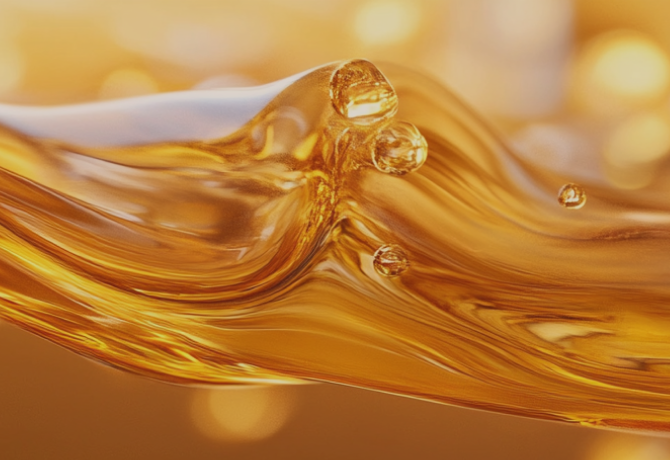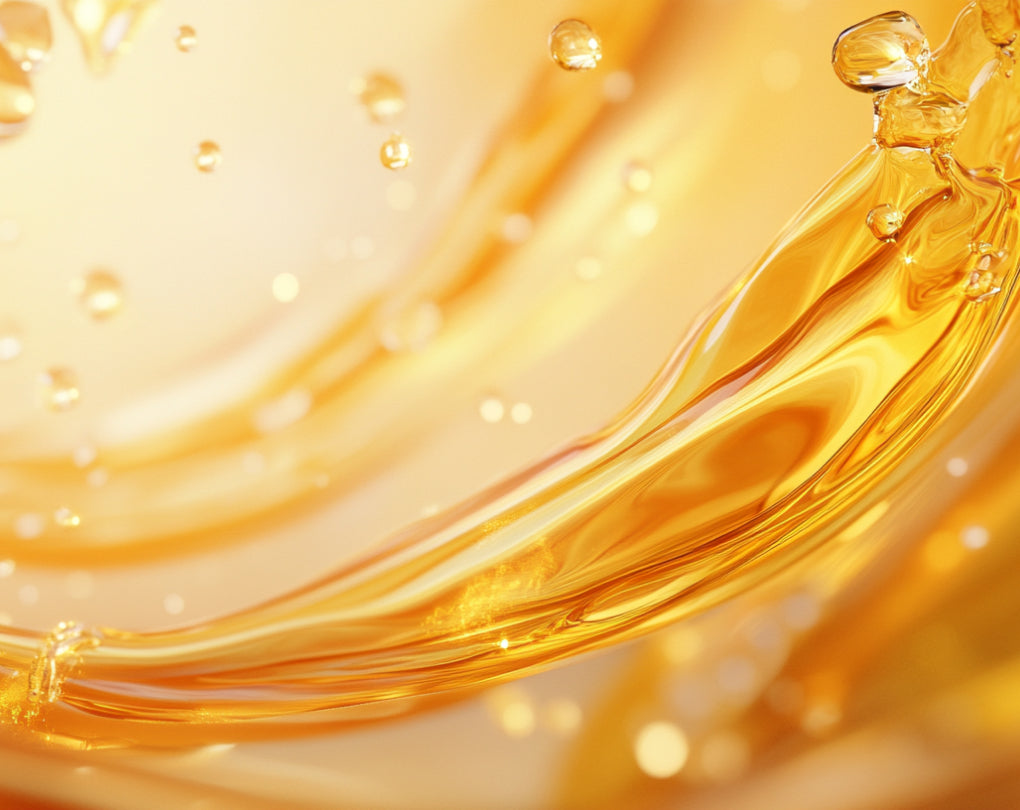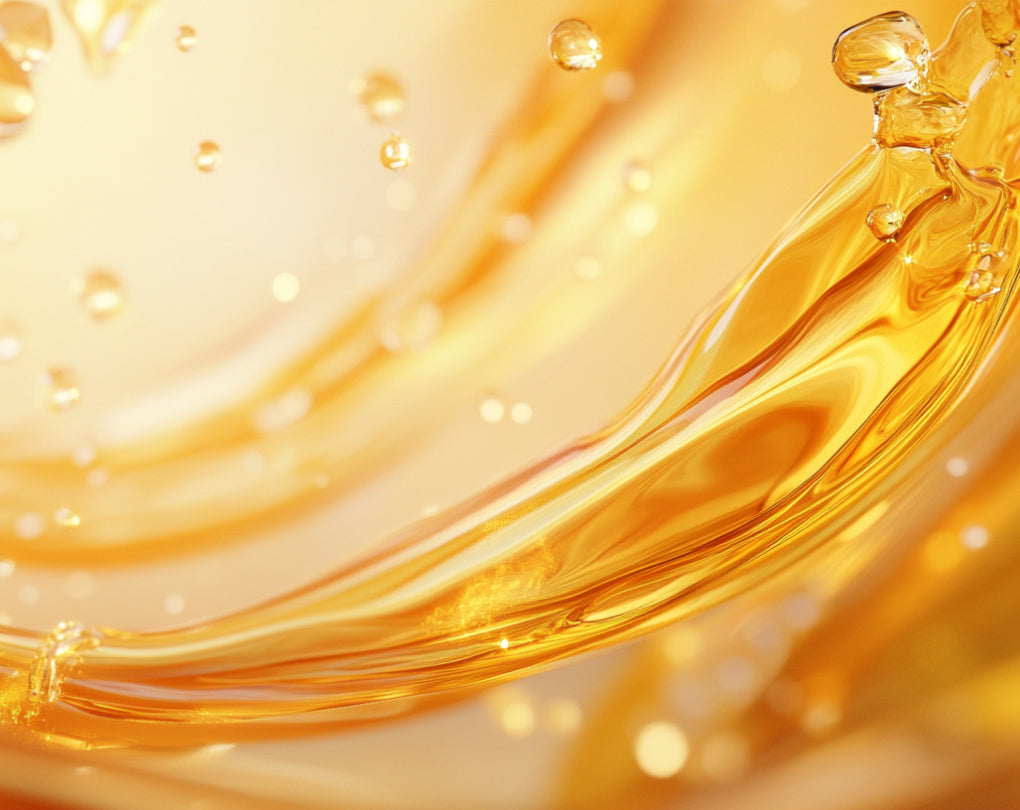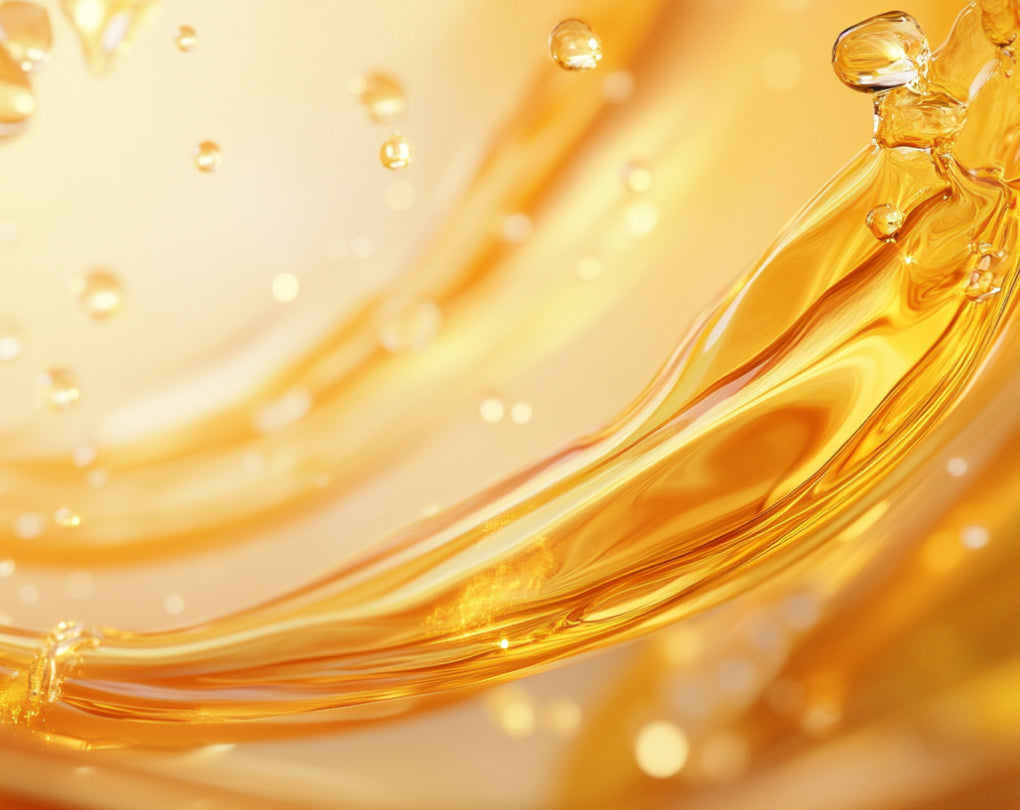Themen dieses Blogartikels:
Table of contents
- Definition: What is fat?
- Oils and Fats: What's the Difference?
- What functions do oils and fats have?
- What about the high energy density of fats?
- Difference between saturated and unsaturated fatty acids
Saturated fatty acids: definition and functions - What are monounsaturated fatty acids?
What are polyunsaturated fatty acids? - Omega-6 fatty acids
- Omega-3 fatty acidsWhere do you get omega-3 fatty acids?
- The right ratio of Omega-3 and Omega-6
- These oils support healthy cell membranes
- Conclusion: Use fats, oils, etc. consciously
- Sources & Bibliography
Definition: What is fat?
Fats, or lipids, are flavor carriers used in frying, baking, and cooking, or in salad dressings. However, their energy content should not be underestimated. Therefore, those who are careful about their diet prefer low-fat foods to save calories.
But fat fulfills several important functions in the body. Instead of avoiding it, you should pay more attention to which fats and their fatty acid composition you use in your cooking.
Oils and fats: what's the difference?
Oils are fats that have a liquid consistency at room temperature. Their low melting point is due to their high content of unsaturated or polyunsaturated fatty acids. This is why olive oil and rapeseed oil are so suitable for cooking.
What functions do oils and fats have?
One of the most important functions of fats is to provide you with energy that your body can store.
Fats and oils also serve as
- Building material of cell membranes
- Flavor and aroma carriers
- Thermal protection and protective padding for internal organs such as kidneys and brain
- Building block for the structure and development of cells and nerve tissue
What about the high energy density of fats?
Fats contain more than twice as many calories as carbohydrates and proteins. Excess fat in the diet is suspected to be linked to diet-related diseases such as obesity, type 2 diabetes, and heart disease.¹
However, it would be wrong to generalize: Some fats can even prevent diseases and have a positive influence.²'³ Therefore, it's important to know which fats are good and which are better consumed in moderation. The distinction between unsaturated and saturated fatty acids plays a role here.
Difference between saturated and unsaturated fatty acids
"Saturation" refers to the chemical structure of fats: A saturated fatty acid has no double bonds, while an unsaturated fatty acid has one or more double bonds, for example, to make membranes more elastic. Saturated fatty acids should make up the smaller portion of your diet . To understand the reasons, let's take a closer look at both fats.
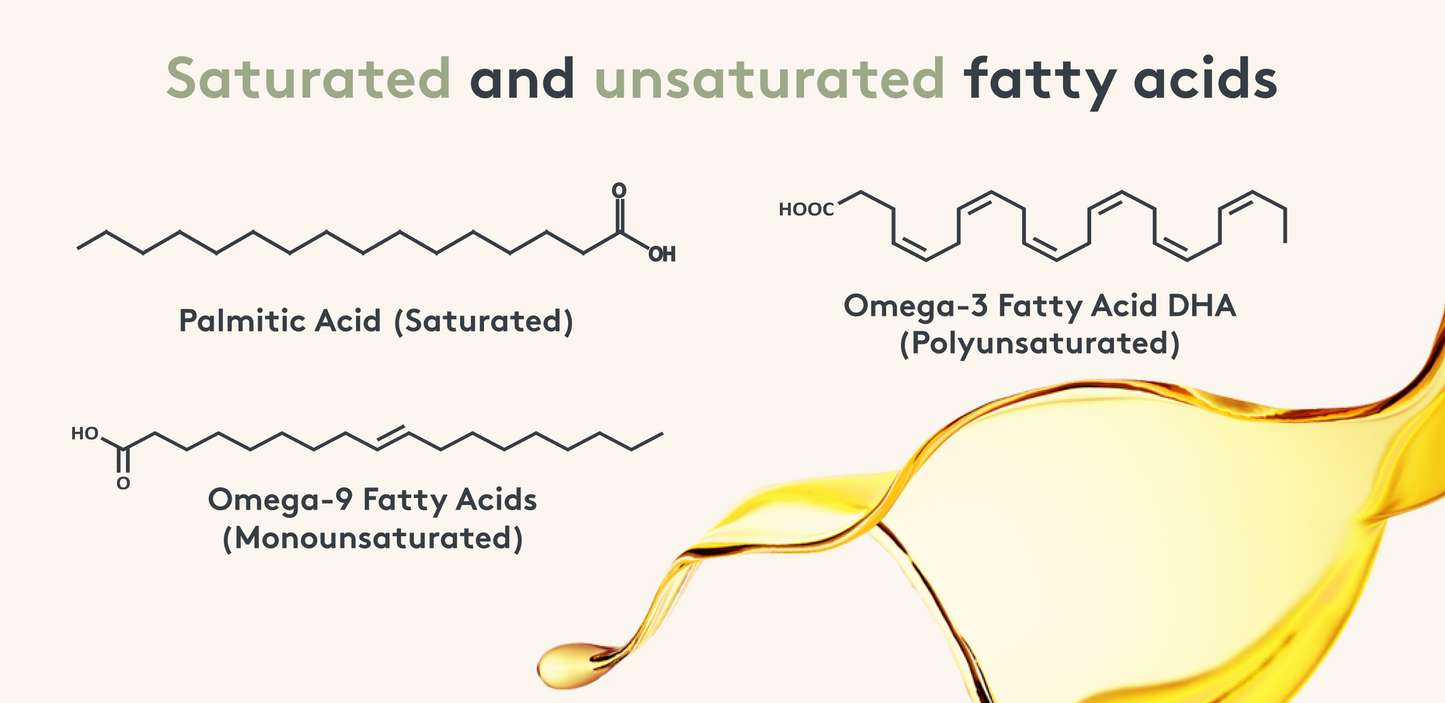

Saturated fatty acids: definition and functions
The body can produce saturated fatty acids itself or obtain them from food. The problem: These fats can raise LDL cholesterol levels.⁴ Since LDL (low-density lipoprotein) cholesterol is considered "bad" cholesterol, saturated fatty acids should make up less than 10 percent of your total daily calories.
Although they are considered unhealthy, they are important for the body in moderation. They serve as an energy source and storage and are involved in organ protection and cell structure, among other functions.
Saturated fatty acids are found in various foods, including:
- Animal fats such as butter
- High-fat sausages
- Cheese
- High-fat sweets
- Coconut oil and palm fat
Coconut and palm oil also contain a small amount of medium-chain fatty acids (around 10 to 15 percent): These so-called medium-chain triglycerides (MCTs) are said to have positive effects on well-being. Special products containing pure MCT oil can be useful in this context.⁵
Example: Caprylic acid
The saturated, medium-chain caprylic acid is also called C8 oil. Because the intestines can absorb it particularly quickly, it quickly enters the bloodstream and can even supply the brain directly with energy.
As a non-essential substance, there is no recommended intake for caprylic acid. However, it may be interesting for people following a ketogenic diet: In the liver, caprylic acid is converted into ketone bodies, which serve as an alternative energy source in low-carbohydrate diets or ketogenic diets.
What are monounsaturated fatty acids?
Monounsaturated fatty acids are considered easily digestible, wholesome, and healthy fats. They can help your body absorb fat-soluble vitamins A, D, E, and K.
Humans can produce a certain amount themselves, but some must be ingested through food. Foods containing unsaturated fatty acids include, for example,
- Vegetable oils such as olive oil, walnut oil or rapeseed oil
- Vegetable spread such as margarine
- Avocados
- Fish such as salmon and herring
- Nuts and seeds
The most important of these fatty acids is oleic acid: This omega-9 fatty acid is important for the function of cell membranes and as an energy source. It may help lower "bad" LDL cholesterol in the blood and thus protect against cardiovascular disease or stroke.⁶
Oleic acid (Omega-9)
The most important representative of these fatty acids is oleic acid: This omega-9 fatty acid is relevant for the function of cell membranes and as an energy source. It could help lower "bad" LDL cholesterol in the blood and thus protect against cardiovascular diseases or strokes6.
Oleic acid is primarily found in olive, rapeseed, or avocado oil. Furthermore, your body is able to produce it itself. Since this fatty acid is non-essential, you generally don't need to worry about a deficiency. Nevertheless, you should make sure not to eat too low-fat, as the body needs certain fats to utilize fat-soluble vitamins.
What are polyunsaturated fatty acids?
Polyunsaturated fatty acids have multiple double bonds . Unlike monounsaturated fatty acids, they are essential and must be ingested through food . They are involved in cell structure, regulate fat metabolism, and support the production of signaling and messenger substances such as hormones .
A high intake of certain essential fatty acids can lower LDL and total cholesterol levels in the human body. We are particularly interested in omega-3 and omega-6 fatty acids .
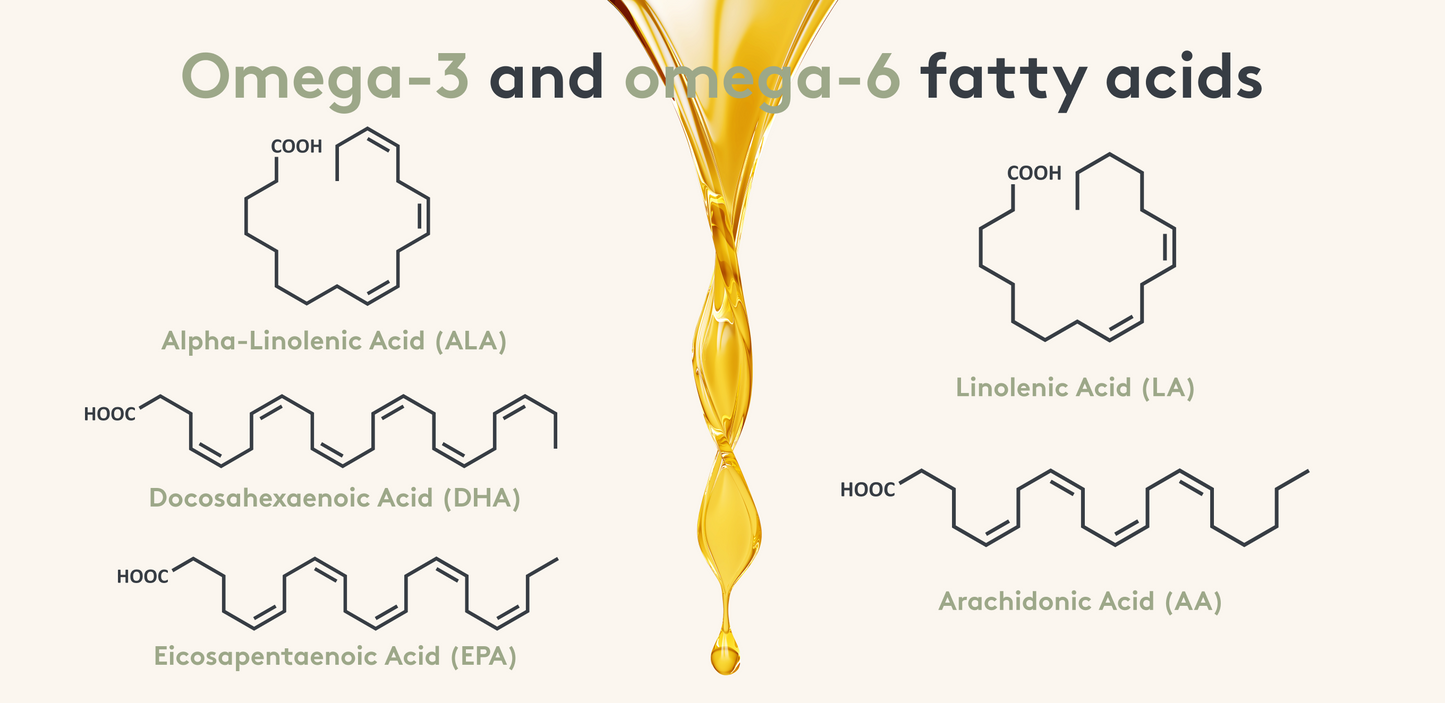

Omega-6 fatty acids
These unsaturated fatty acids, which include linoleic acid and arachidonic acid, have a bad reputation because foods typically contain significantly more omega-6 than omega-3 fatty acids.
They make an important contribution to health, for example through their conversion to prostaglandins , substances that influence the spread and severity of inflammation. In cases of omega-3 fatty acid deficiency or omega-6 fatty acid excess, increased levels of group 2 prostaglandins are produced. These have an inflammatory effect and may thus contribute to the development of arteriosclerosis and many other inflammatory diseases.⁷
Omega 6 and Omega 3 compete for an enzyme during conversion into their functional form. If their ratio is incorrect, the activation is unbalanced, and the effects of one group predominate
Omega-3 fatty acids
Omega-3 fatty acids include alpha-linolenic acid (ALA), docosahexaenoic acid (DHA), and eicosapentaenoic acid (EPA). EPA and DHA are particularly important for your body: They are formed, among other things, from ALA, although this conversion is often inhibited by high levels of omega-6 fatty acids.
Omega-3 fatty acids are incorporated into cell membranes and stored there as phospholipids . Phospholipids ensure the stability and elasticity of cell membranes and serve as storage for EPA and DHA . When needed, these fatty acids are released and used as precursors for eicosanoids – hormone-like substances that control various bodily functions and are converted into, among other things, prostaglandins.
Good to know: In contrast to omega-6 fatty acids, EPA forms group 3 of the prostaglandins, which has a more anti-inflammatory effect.
Advertisement
300 ml Premium Natural Omega 3 Oil from sustainable wild catch
1460mg EPA and 910mg DHA
-
Natural 1.6:1 ratio
Fatty acid complex of 27 fatty acids
Lemony, pleasant taste, no fishy taste
Totox value of 7.7 & purified from heavy metals & Co
Laboratory tested
Developed with doctors & experts


Where do you get omega-3 fatty acids?
EPA and DHA intake can be obtained from fatty fish, seafood, and algae. Make sure to look for organic certification , for example, in the case of algae farming, and the lowest possible levels of pollutants and heavy metals.
Since the quality of many fish and omega-3 sources is suffering due to the global plastic and waste problem and overfishing of the oceans, you can use supplements without having to worry about environmental pollution. When purchasing omega-3 supplements, pay attention to product quality and origin. Also pay attention to the Totox value – this freshness value indicates how strongly the oil is oxidized. A lower value indicates fresh, high-quality oil that is less susceptible to harmful oxidation and therefore better for your well-being.
MITOcare products meet these parameters. They provide you with sufficient EPA and DHA – without a fishy taste.
Incidentally, the intake of ALA can improve EPA/DHA levels if the conversion to these fatty acids is successful, i.e. the enzyme is not busy with omega-6 fatty acids.
The right ratio of Omega-3 and Omega-6
Omega-6 and omega-3 should be consumed in a specific ratio: a ratio of 1:1 to 5:1 is recommended. Too many omega-6 fatty acids block corresponding omega-3 reactions and can increase inflammation.
However, the German diet usually contains products that contain much more omega-6, so the typical ratio is closer to 20:1. So, make a conscious effort to include more omega-3 foods in your diet.
These oils support healthy cell membranes
The body needs certain fatty acids to build cell membranes, which consist of a colorful mix of lipids, accounting for about 76 percent of the membrane depending on the cell type. Just four tablespoons of oil per day can actively support your cell membranes.
You shouldn't use just any oil, but one of the following cooking oils:
- 1 tbsp polyphenol-rich , organic extra virgin olive oil (cold-pressed, tastes slightly bitter due to the polyphenol content)
- 1 tbsp fish or algae oil (pay attention to quality, preferably heavy metal-free)
- 1 tbsp MCT oil (medium-chain fatty acids extracted from coconut oil)
- 1 tablespoon of a phospholipid-rich liquid, which cell membranes are mainly composed of, for example our Lipo Curcumin Booster CURCUMIN or Lipo Glutathione Booster.
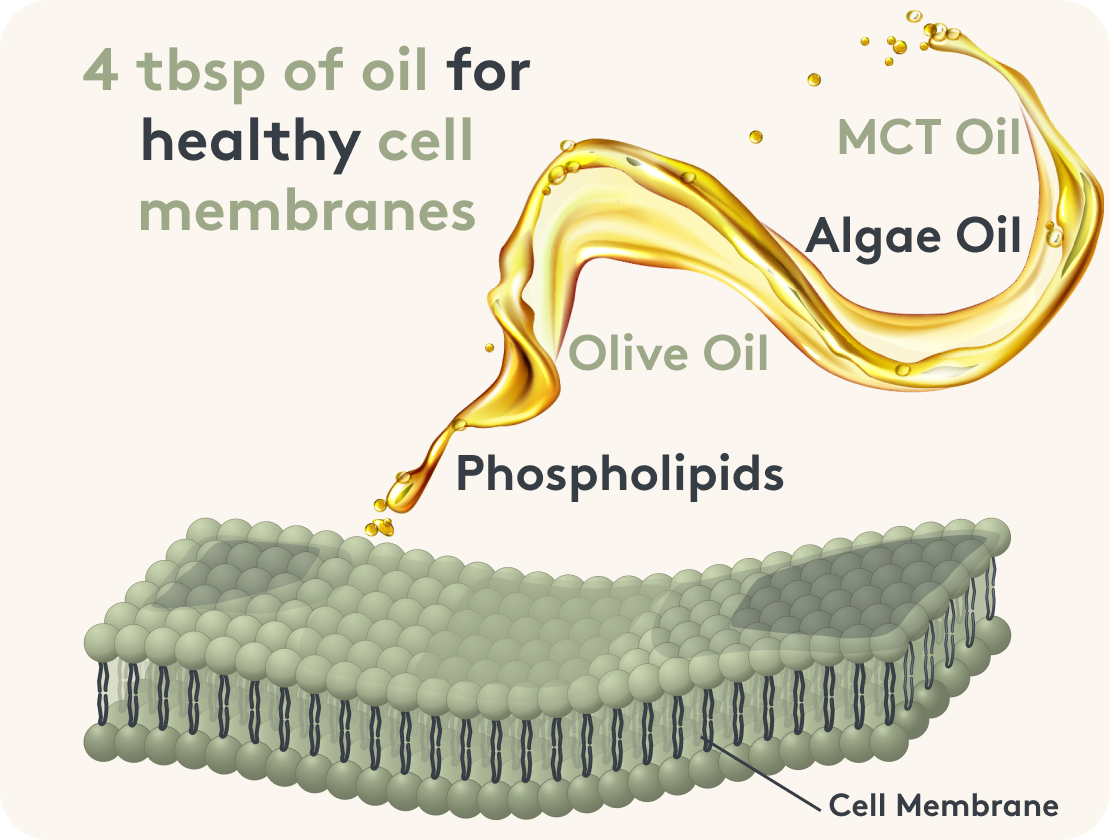

Conclusion: Use fats, oils, etc. consciously
The choice of fats and oils you use in your food should not be primarily a question of calories, but rather based on their fatty acid composition . As with all questions concerning nutrition, the answer for fats and oils is: Conscious and informed consumption will get you further.
This article is based on carefully researched sources:
Bibliography
- Ofori, S. A., Dwomoh, J., Owusu, P., Kwakye, D. O., Kyeremeh, O., et al. (2024). Dietary Fat Intake on Metabolic Health: An in-Depth Analysis of Epidemiological, Clinical, and Animal Studies. American Journal of Biomedical and Life Sciences, 12(4), 68-77.
- Khan, S. U., Lone, A. N., Khan, M. S., Virani, S. S., Blumenthal, R. S., Nasir, K., Miller, M., Michos, E. D., Ballantyne, C. M., Boden, W. E., & Bhatt, D. L. (2021). Effect of omega-3 fatty acids on cardiovascular outcomes: A systematic review and meta-analysis. EClinicalMedicine, 38, 100997.
- Meyer, N. M. T., Pohrt, A., Wernicke, C., Pletsch-Borba, L., Apostolopoulou, K., Haberbosch, L., Machann, J., Pfeiffer, A. F. H., Spranger, J., & Mai, K. (2024). Improvement in Visceral Adipose Tissue and LDL Cholesterol by High PUFA Intake: 1-Year Results of the NutriAct Trial. Nutrients, 16(7), 1057.
- ernaehrungs-umschau.de/news/24-08-2017-studien-zeigen-erhoehte-ldl-konzentration-im-blut/
- fet-ev.eu/mittelkettige-fettsaeuren/
- Lopez-Huertas E. (2010). Health effects of oleic acid and long chain omega-3 fatty acids (EPA and DHA) enriched milks. A review of intervention studies. Pharmacological research, 61(3), 200–207.
- Gomez, I., Foudi, N., Longrois, D., & Norel, X. (2013). The role of prostaglandin E2 in human vascular inflammation. Prostaglandins, leukotrienes, and essential fatty acids, 89(2-3), 55–63.
